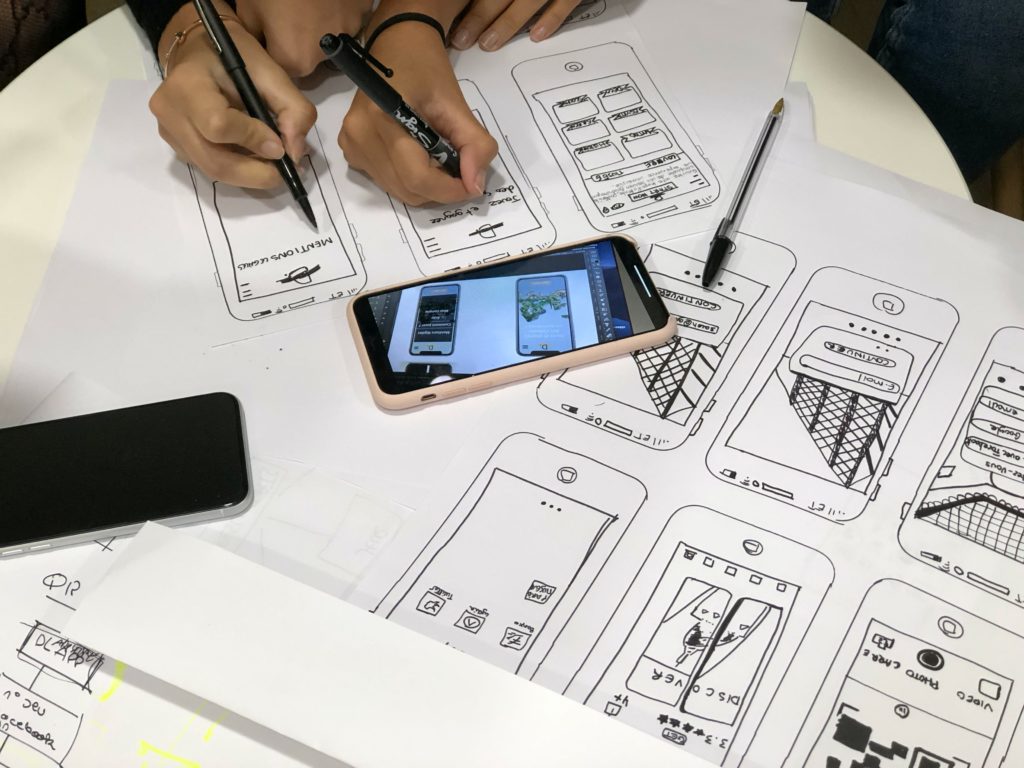The Ultimate Guide to Developing Web and Mobile Apps
The development of web and mobile applications is becoming an increasingly popular service, and this trend shows no signs of slowing down. The world of technology is evolving at a rapid pace and new innovations are changing the way we live, work, shop and play. In particular, the growth of web and mobile applications has revolutionized the way we access information and services. The app market has expanded so rapidly that it is now a billion-dollar industry. It is projected to grow to $430.90 billion in 2022. (Source: Statista).
Users demand applications that are fast, reliable, secure and easy to use. With the right technical knowledge and business strategy, web and mobile application development can take your marketing strategy and website to a new level.
This guide will explain everything you need to know to get started building your own app.
What is an application?
An application is a piece of software designed to work on smart devices (most often mobile phones and tablets) and/or computers. Apps can be used for almost everything from education to entertainment, banking, shopping, travel and more.

There are two main types of applications:
- Web apps are used on computers, smartphones and tablets and are accessed via a browser
- Mobile apps are used only on smart devices (phones, tablets and televisions), and are downloaded and installed via the app store. Mobile apps have significant advantages over web applications. They can work offline and users can find them more easily by searching app stores (like Apple Store, Google Play or Microsoft Store).
Advantages of web and mobile app development
The advantages of developing a web or mobile apps are numerous. Perhaps the most obvious benefit is that it can help you reach a larger audience than you would if you were limited to a physical store or office. Other benefits include the ability to track user data, the ability to offer targeted promotions, and the ability to accept payments electronically. Additionally, the app can help build customer loyalty and brand awareness. Finally, the app can provide a unique and convenient user experience that can result in increased sales and repeat purchases.
Why apps are better than websites
While there are many benefits to developing a web or mobile app, there are also a few key reasons why apps are often considered better than websites. One reason is that apps are more likely to be used regularly because they are usually easier to access than websites. Another reason is that apps tend to offer a more immersive and interactive experience than websites. Finally, apps can take advantage of phone features like push notifications, which can help keep users engaged.
Advantages of apps over websites include:
- Faster access to information and services
- Mobile applications are designed for users who want to quickly and conveniently access information or services. On the other hand, websites are designed for those who prioritize a thorough, thoughtful experience
- Increased revenue – Apps have been shown to generate around 10x more revenue than mobile websites for many industries, including retail, travel, entertainment and healthcare
- Improved brand recognition
- Apps can help create brand identity and promote products. The apps you build and integrate into your marketing strategies can become a recognizable brand in their own right, facilitating customer retention and expanding your reach.
How to create a web and mobile app
Creating an app can be a great way to bring your vision to life, but it takes more than just a good idea to make a successful app. You need to have a clear purpose of the app, research, choose the right platform, design the user interface and develop it for users and search engines. You also need to submit your app to the right app stores and promote it to reach your audience.
What are the different stages of app development?
The application development process can be broadly divided into four phases: idea, design, development and testing.
Idea refers to coming up with the initial plan for your app. This is where you decide what problem the application is trying to solve and how the app will help in this.
Once you have an idea, it’s time to design. At this step, the user interface and experience for the application is created. This is where one thinks about how users will interact with the application and what features should be included.
After design comes development. This is where the design turns into a working application. If you are experienced in programming, you will create new code yourself and create an application. If not, you will hire a professional developer to create the app.
Finally, it’s time to test the app. This is where everything is checked to see if everything is working correctly and all errors are eliminated. After the application has been tested, it is ready for work and to be promoted.
If you are a beginner, it is definitely best to hire agencies that can do all these steps for you. The development of web and mobile applications is a very complex and time-consuming process that can be shortened by using the experience and knowledge of professionals.

Steps in developing the app:
1. Purpose of the app
The first step in creating a successful app is defining a purpose. What are you trying to achieve with your app? What problem are you trying to solve? Do you want to generate leads, increase sales, or provide customer support? Once you’ve defined that, you can determine your target audience and what features the app will need to include.
2. Research
Once you’ve defined the purpose of the app, it’s time to do some research. This includes everything from understanding your competition to assessing the platforms and devices your target audience uses. You need to make sure that the app is unique and will appeal to the target market. You should also ensure that it is technically possible to build the app on the platform you have chosen.
3. Choosing the platform
Once you’ve done your research, it’s time to choose a platform. The two most popular mobile app development platforms are iOS and Android. Each platform has its strengths and weaknesses, so it’s important to choose the one that’s right for your app. If you’re not sure which platform to choose, talk to a developer or consult with an app development agency.
4. App design
Once you’ve chosen a platform, it’s time to design the app. This includes everything from choosing the right colors and fonts to designing the user interface and user experience. The application should be visually appealing and easy to use. A good way to test a design is to ask people who are unfamiliar with the app to try it out and provide feedback.
5. Application development
After the design of the application, it is time for development, that is, programming. This process includes coding, testing and debugging. It is important to ensure that the application is free of programming errors and other errors before you run it. You also need to ensure that it is optimized for both users and search engines.
6. Submit the application to the store
This only applies to mobile apps, not web ones. Once the app is developed, it’s time to submit it to app stores like:
7. Promote the app
Once the app is live in stores or on the web, it’s time to promote it. This includes everything from social media marketing to paid advertising. The audience needs to know that the app exists and how it can be useful to them.

What are some common mistakes during app development?
One common mistake during application development is improper planning. Then insufficient testing of the application before launch. It’s important to make sure everything is working properly before releasing your app to the world.
Finally, another common mistake is not promoting the app enough. Once the app is live, people need to be notified about it. For this, a marketing plan should be created so that the web or mobile application reaches as many people as possible.
Types of Apps
There are three main types of applications: native, web and hybrid. Each has its advantages and disadvantages.
- Native applications are written specifically for specific platforms, such as iOS or Android. They are usually faster and more responsive than web or hybrid applications. However, they can be more expensive to develop and require users to download and install them.
- Web applications are built using web technologies such as HTML, CSS, and JavaScript. They can be accessed through a web browser on any device. They are usually cheaper and faster to develop than native applications. However, they are not as fast or responsive as native apps and may not have access to all device features.
- Hybrid applications are a combination of native and web applications. They are developed using web technologies, but they are packaged in a native application that can be installed on the device. They have the same advantages and disadvantages as native and web applications.
Application costs
App development costs vary depending on the type of app, functionality and complexity. To get an accurate estimate, you should create a detailed application prototype and project schedule. Other factors that affect app development costs include the size of the development team, the app development platform used, and the cost of living in the development region.
If you want to save on web and mobile app development costs, consider using a cost-effective app development platform.
Integrated marketing campaigns with applications
Once the app is ready, you can use it to create integrated marketing campaigns to promote your products and services.
A few examples of how you can use your app to promote your business.
- Use the app as a lead generator: Create a lead generator within your app and offer a promotion or offer to anyone who signs up. This will help you attract more customers and give them an incentive to download and use the app.
- Offer exclusive content or services: Create exclusive content or services that can only be accessed through the app. You can use this to highlight your brand and encourage users to return to your app again and again.
- Create a customer retention campaign: Offer your repeat customers exclusive content or services that can only be accessed through the app. This will help to keep them and bring them back again.
CONCLUSION
Applications have become an essential part of modern life. With the right app, you can create a useful and enjoyable experience for your customers and build your brand at the same time. Nije važno pokušavate li privući kupce, zadržati postojeće ili čak pomoći zaposlenicima. With the right app, you can make your communication interactive and engaging.
If you need the development and design of a web or mobile application, feel free to contact us via email or contact form.
You can view our works in the portfolio, and if you liked this article, read some more on our blog.
Thank you for reading! 🙂





